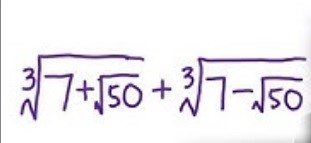-
Posts
5447 -
Joined
-
Days Won
53
Content Type
Profiles
Forums
Events
Everything posted by Genady
-
It might be OT, but since you said this several times in different posts, I wonder, why do you say this.
-
Metaphorically speaking. But technically, is it a TM? We don't know. TM is a mathematical architecture of organization and function. It is independent of physical / chemical / biological implementations. Computers are TM, but it is unknown about the brain. It is an architectural rather than physical / biological question.
-
And now to something completely different: https://www.scienceforums.net/topic/131507-find-the-numerical-value/ Numeric rather than alpha numeric puzzle.
-
A connection between your fear to enter that house and that guy electrocuting himself some days later seems quite incidental.
-
ABC+DEF=GHIJ
-
This is a great feature. "Billions" of years of people's live time saved.. Just to clarify, I didn't mean that the general feature of autocomplete is pointless. I use it often myself. I was only talking about it being pointless when a new thread title is entered as described in the OP.
-
I am sorry. Will remember to do it from now on. Thanks.
-
When my father was ill and his condition deteriorating, I said to my wife one day, "He will die on [my daughter]'s birthday." Several days later, in the morning of that exact day, he did. I always thought of this experience as a combination of extrapolation and coincidence.
-
I'd donate a toaster or two for the study.
-
91/8 nine times.
-
I think this argument can be greatly simplified if we remember that computer, regardless of its "complexity", evolution, or self-evolution, is and will be, a Turing Machine. The argument says that TM can't be sentient.
-
Another: Four -1's and five 1's. Or: Four 1's and five -1's.
-
Exactly. That's why I've objected to the statistical argument above,
-
Nine zeroes will do.
-
Right. Also, there are no statistics about people feeling things, not saying, and nothing happening.
-
Of course, there are many holes in science yet to be filled. Otherwise, scientists would be out of job. But I want to say a few words about statistics. So, you turn switch once and a device blows - coincidence, but if you turn switch 20 times and 20 devices blow is less tenable? No, it is not. If it was 20 out of 20, sure. But if it was 20 out of 1000, not. 2% still mean coincidence. Did it really happen each time? Do you have these statistics? Another statistical consideration is like this. Let's say that on average it happens 1% of times. This means that there is one person in, say, 100 to whom it happens 2% of times. There is one person in 1000 to whom it happens 3% of times. There is one in 10000 to whom it happens 4%, one in 100000 with 5%, etc. Could you just happen to be that one out of 100000? Somebody is. Maybe this is the explanation why things like this happen to only some people? Straightforward statistics? There are statistical methods to refute null hypothesis with a desired level of confidence, but they need data.
-
I don't know how to talk to a five year old, but I tried to make it clear: It starts fine, but then goes into a nonsense: Here I gave up.
-
If the two V's move toward each other with the same speed relative to the fluid, then in the fluid's reference frame they have the same flattened shape and they nicely go into each other. The fluid being at rest relative to one V or to another, or neither, are different physical scenarios, and the different outcomes don't constitute a paradox. The whole point of the analysis is that you need to consider not only the length contraction effect, but relativity of simultaneity. Compare to the ladder/barn paradox with one V being a "ladder" and the other being a "barn". Ladder paradox - Wikipedia
-
My response was, and still is unless I am wrong, that the answer depends on how the fluid moves. If it moves together with the green V, i.e., rests relative to the green V, it will be trapped. If it moves together with the purple V, i.e., rests relative to the purple V, it will escape.
-
It seems to get worse. Me: It: Me: It: I guess, I am a bad teacher. I don't have the patience...
-
To see what happens to the fluid you need to analyze the order of events in its reference frame. The result will be different depending on how the V's move relative to the fluid / how the fluid moves relative to each V.
-
The null hypothesis: coincidence.
-
Yes, this is a crucial condition:



